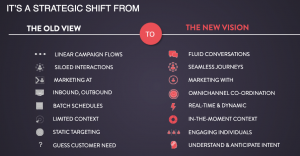
With this in mind, it is time to look with fresh eyes at how brands can deliver on customer engagement, and at how brands and marketers can build experiences and more meaningful long-term relationships that meet customer expectations. Ultimately, these days, customers today want to manage their own journey, and it’s up to brands to understand what they need and then deliver value with every interaction, no matter where or when that takes place.
Read more: Goldilocks Principle of Marketing: The Need for a Consistent View of the Consumer Journey
Seamless customer experiences build relationships
In March 2019, Thunderhead surveyed 4,000 consumers in the US and UK to uncover what consumers expect of brand experiences across the banking, auto, insurance, telco, energy, and retail sectors. Titled Driving The Customer Journey into 2019 and Beyond, the results of Thunderhead’s report were interesting. We found 94% of consumers were frustrated by disjointed experiences and poor customer journeys.
When a customer interacts with a brand, he or she is interacting with a collection of different moving parts, including sales and marketing, digital, mobile and e-commerce management, and various backroom functions such as inventory and supply chain management. The problem is that these departments might be optimized for their specific function, but they are sub-optimal at looking at the world through the lens of the customer’s full journey with the brand.
The situation is exacerbated by the multiplicity of touchpoints, with around three in five consumers (58%) admitting to having a different experience from the same brand depending on the channel they use. This is an urgent issue that brands are clearly struggling to address. The secret to delivering a quality customer experience is to ensure that the customer doesn’t notice these silos. With almost one-third of customers (31%) still regarding their interactions with brands as merely transactional, there is clearly more than brands can do to build relevant and memorable experiences. Continuity is critical.
Customer Loyalty is being challenged
Consumers have told us they are no longer willing to put up with poor customer experience and will look elsewhere for products and services if they’re dissatisfied. Two in five of the consumers Thunderhead surveyed (38%) have already taken action and stopped buying from a brand altogether as a result of a bad customer service experience in the last year.
This is worrying news for customer retention; consumers are unforgiving and a negative experience can have a direct impact on the size – and profitability – of a brand’s customer base.
Indeed, the damage to a brand can go beyond just the loss of a customer. Our survey showed four out of five (82%) disaffected customers will share their views on their experience widely – especially over social media. Of these, 20% said they’d share their thoughts with more than five people, while 7% said they’d share with more than 10. Negative sentiment on social media can spread exponentially, and brands can risk ‘death by social’. It is therefore critical brands ensure every experience is the best they can deliver.
Customers are willing to pay a premium for better responses
All is not lost, however; if brands are willing to listen, then consumers know what they want. In fact, around a third of customers (35%) are even open to the idea of paying more if the experience is seamless. What consumers want above all else are faster responses, real-time recognition, and an understanding of their context so that the interaction with a brand is easy. Context and customer knowledge clearly matter as demonstrated by the 77% of consumers who said their experience of a brand would be improved if that brand interacted with them via their preferred channel. But brands have to get this interaction right or their customers will punish them.
Three in ten consumers (29%) said they’d consider changing to another retailer or provider if they felt comms from a brand to be an invasion of their privacy. And one in five said they’d consider changing if they received no communication at all. That said, more than three quarters (77%) admitted they’d feel more positive about a brand if it engaged in an ongoing conversation that was beneficial to them, as opposed to simply trying to sell them something.
What’s more, should customers see these communications as representing genuinely better value and service, they’re far more likely to be willing to share personal information in return – particularly in exchange for loyalty programs, time-saving opportunities, and priority customer services. Striking the right balance in terms of both the frequency and content of customer interaction is a tricky business. It is important to think of it as a conversation. There is as much to be lost as there is to be gained, depending on how far a brand deviates to either side of what appears to be a fairly thin line.
Marketing with customers not at them
In order to create the ideal customer experience, brands must be able to make sense of the wealth of interaction and touchpoint signals in real-time to identify the customer and what it is they’re wanting to do. This requires a change of mind set from the brand; instead of asking what it’s trying to sell, the brand now needs to ask how to serve the customer.
This is what we at Thunderhead refer to as an ‘intent-driven’ approach to customer journeys. Unlike the more traditional approach, in which product is pushed to a particular customer segment, intent-driven journeys the customer becomes central, recognizing their individual goals and helping them to meet them at the moment they’re interacting. Using all the available insight and context, the brand can then call upon its mobile communications, sales team, or call operators in order to demonstrate its attentiveness to the customer and their needs and of course treat them like a human being, not a ‘target’.
 Conclusion
Conclusion
The role of the customer journey has now been elevated from delivering planned actions to fostering relationships. We must ensure that these relationships are driven by the customer. It is time, therefore, that we stopped dictating customer journeys, and started enabling them.
Read more: Four Ways To Measure The Always-On Consumer











Comments are closed.